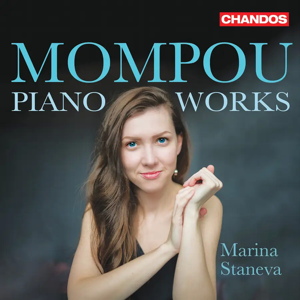
Federico Mompou (1893-1987)
Paisajes (1942-1960)
Variations sur un thème de Chopin (1938-1957)
Cançons i danses (1921-1962)
Marina Staneva (piano)
rec. 2023, Potton Hall, Dunwich, UK
Chandos CHAN20276 [82]
During the pandemic Marina Staneva was introduced to, and fell in love with, the Variations sur un thème de Chopin and has chosen to record it alongside two other collections; the twelve songs and dances and the three landscapes. Though both of these sets share a common theme they were actually written over several decades as were the variations; the first and best known of the Cançons i danses appeared in the 1920s and the final one was written in 1962 whilst the landscapes were written in 1942, 1947 and 1960 respectively.
The Variations sur un thème de Chopin are the result of three inspirations; one was the cellist Gaspar Cassadó who in 1938 had suggested the idea of variations on this theme – the prélude in A major from op.28 – for cello and piano. The original plan never came to fruition but four variations were written. The second was in 1957 when London’s Royal Ballet asked for a follow up to his ballet The House of Birds, choreographed by MacMillan and based on his piano pieces. Mompou thought to offer his variations, adding to the original four variations; the projected ballet didn’t make it to the stage but the variations were now in their finished state. The final inspiration, and the most important one, is of course Chopin himself; Mompou was a huge admirer of Chopin’s music and in 1929 he recorded his own tastefully sumptuous arrangement of the A minor waltz op.34 no.2 (available on Sakuraphon SKRP78011 great Chopinzees and Marston Records 52075-2 which features his other early recordings). The variations are an extended tribute with jazz influences that Staneva notes in the booklet and delicious harmonies; the first variation with its additional sevenths, ninths and other inner passing notes is very much in the style of his waltz arrangement. Like Godowsky in his arrangements of the études he honours Chopin’s affection for the mazurka and waltz – variations five and nine – and even offers a simple hymn-like version of the central melody of the fantaisie-impromptu as a foil to the intense Evocation, variation ten, which also alludes to his own Cançons i danses no.6.
The Cançons i danses – songs and dances – were a genre that Mompou was to return to throughout his composing career; he wrote versions for guitar and organ when he was nearly eighty. The broad format is that of a lyrical section coupled with a rhythmic dance though it is not as rigid as that – the eleventh features two dances with a reprise of the song in between them for example. The songs are often based on folk melodies or, in the case of the tenth, the cantigas de Santa Maria by 13th century composer and poet Alfonso X, King of Castile and Léon which is given an appropriately archaic treatment by Mompou; the stately but mournful song of Alfonso is coupled with an elegant minuet. The ninth, based on Catalan tunes, almost sounds like one of Percy Grainger’s folk-song arrangements and Mompou has chosen a dance that seems to grow out of the melody of the song. Likewise in the fifth the dance gradually rises out of the song, marked lento liturgico gently contoured and heartfelt in its yearning quality; the dance is hesitant at first, seemingly unwilling to intrude on the mood but unable to contain its joy it becomes more and more carefree. Staneva captures Mompou’s widely contrasting moods with ease, from the fragility of the third with its Catalan Christmas carol to the vigour of the sixth’s creole dance. If Stephen Hough is a little more rhythmically flexible in the small selection he recorded (Hyperion Records CDA66963) there is nonetheless plenty of charm in Staneva’s playing – number seven a case in point with its dance played as a duet between a shy and slightly halting young man and his winsome partner.
The Paisajes – landscapes – were written after a decade of creative inactivity and it was only a return to Barcelona in 1942 and meeting Catalan pianist and Mompou’s future wife Carmen Bravo, that he began to compose again. The first is la fuente y la campana – the fountain and the bell – a melancholy piece depicting a courtyard within earshot of cathedral bells. The bells are quite indistinct in the middle section, almost melding with the gentle splash of the water and it is only in the harmonically alter ending where the bells toll alone, briefly and sadly. Montjuic Park in Barcelona provides the inspiration for el lago – the lake – and the main body of the piece has a melody floating over a gently flowing accompaniment. Mompou describes a frog jumping about, presumably in the shimmering passages in the middle that also echo the fountains of the park in a quasi Ravelian style. These two pieces were dedicated to Carmen Bravo and another pianist was the dedicatee and inspiration of the third Carros de Galicia – Carts of Galicia – a memory of the sights and sounds of village life in Galicia, the distinctive sound of the carts echoed in the pulsing, syncopated accompaniment. Written thirteen years after the second its harmony, as with the later Cançons i danses is a little more acerbic.
I was taken with Staneva’s playing in her début CD Slavic Roots, with piano music by Pancho Vladigerov on Chandos (review) and equally so here. Her tone is rich and even and if her playing is occasionally a just a little forthright she clearly enjoys the subtleties of Mompou’s writing and his sudden harmonic twist and turns; his multi-layered and often quite delicate textures are balanced beautifully.
Rob Challinor
Help us financially by purchasing from




















